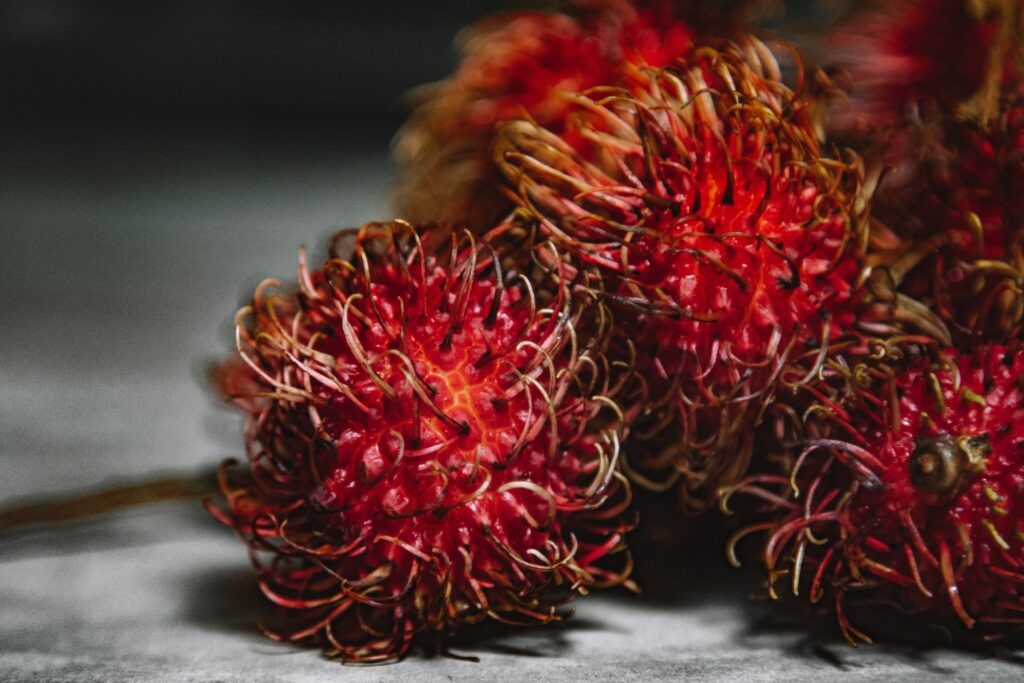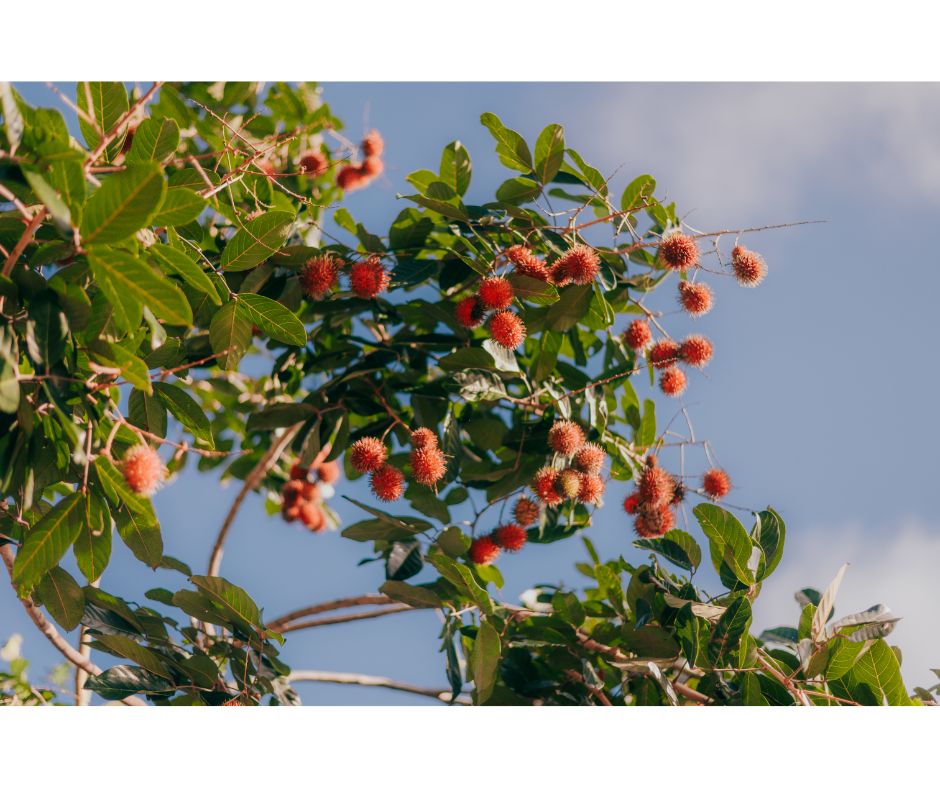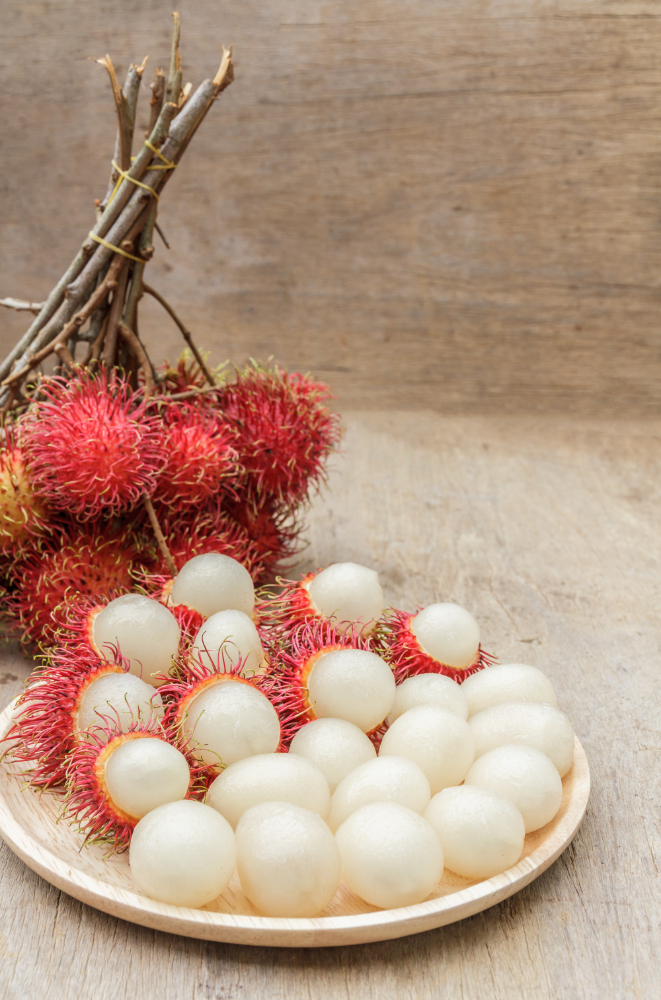Exploring the Sweet Delight of Rambutan Fruit: Benefits, Origins, and More

Introduction:
Imagine stepping into a lush tropical orchard where vibrant rambutan dangle from trees, their exotic aromas filling the air. Amidst this natural beauty, the rambutan tree stands tall, adorned with clusters of fascinating fruits that beckon with their vibrant colors and unique appearance. If you’re curious about this gem of nature, join us as we delve into the world of rambutan fruit, uncovering its benefits, origins, and the wonders it holds.
Quick Jump to topics:
What is Rambutan?
Rambutan, often referred to as the “hairy fruit,” is a small, round fruit with a unique appearance. Its name is derived from the Malay word “rambut,” which means “hair,” and rightfully so – the fruit’s outer skin is covered in soft, spiky hairs, giving it a distinctive and intriguing texture. Beneath this hairy exterior lies a succulent, translucent flesh that ranges from pale white to slightly pink, encasing a single large seed.

Rambutan Benefits for Health:
Beyond it’s alluring appearance, rambutan fruit offers an array of health benefits that make it a valuable addition to your diet. Rich in vitamins C and A, it also contributes to a robust immune system and promotes healthy skin. The fruit’s natural antioxidants help combat free radicals, potentially reducing the risk of chronic diseases.
Moreover, it contains essential minerals like iron, copper, and potassium, which support healthy blood circulation and aid in maintaining optimal blood pressure levels. The juicy flesh also provides a hydrating effect, making it a refreshing choice, especially in tropical climates.

Unveiling the Rambutan Tree:
The tree of this fruit (Nephelium lappaceum) is a captivating evergreen tree that thrives in the tropical havens of Southeast Asia. Standing gracefully with its glossy leaves and extending branches, it offers not only a mesmerizing sight but also a bountiful harvest of fruits. These trees can reach heights of up to 80 feet, creating a canopy of shade beneath which these delightful fruits mature.
Nutritional Profile:
The nutritional profile of this fruit adds to its allure as a healthful choice. A 100-gram serving of this fruit contains approximately 68 calories and offers about 16.5 grams of carbohydrates, making it an energy-rich fruit. It’s also a good source of fiber, providing around 0.9 grams per serving.
| Nutrient | Amount per 100g |
|---|---|
| Calories | 68 kcal |
| Carbohydrates | 16.5 g |
| Dietary Fiber | 0.9 g |
| Sugars | 9.61 g |
| Protein | 0.65 g |
| Fat | 0.21 g |
| Vitamin C | 20.9 mg |
| Vitamin A | 31 µg |
| Calcium | 22 mg |
| Iron | 0.35 mg |
| Potassium | 42 mg |
| Phosphorus | 9 mg |
| Magnesium | 7 mg |
Please note that these values are approximate and can vary based on factors such as the variety of rambutan and its ripeness. Nutritional content can also vary based on cultivation practices and other environmental factors. Rambutan is a low-calorie fruit that offers a modest amount of essential nutrients, including vitamin C, dietary fiber, and some minerals. It’s a delightful addition to a balanced diet, contributing to your daily nutrient intake and providing a burst of tropical flavor.
How to Enjoy Rambutan Taste:
Peeling this fruit can be an adventure in itself. Start by making a shallow cut around the circumference of the fruit, being careful not to pierce the juicy flesh. Gently twist the fruit open, revealing the pristine white or pinkish interior. Pop the succulent flesh into your mouth, savoring the delicate combination of sweetness and acidity. If wanna know more about weird fruits click here
Culinary Uses and Enjoyment:
This fruit is sweet and slightly acidic flavor profile, makes it a versatile ingredient in both sweet and savory dishes. Its juicy texture adds a delightful contrast to fruit salads, while its unique taste can elevate sauces and chutneys. In some regions, this fruit even enjoyed as a dessert ingredient, either fresh or in delectable preserves.

Origins and Cultural Significance:
Originating in the Malay Archipelago, it has not only captured hearts with its flavor but has also woven itself into the cultural fabric of various countries. It holds cultural significance in Southeast Asian nations, where it symbolizes abundance, prosperity, and good fortune. Festivals celebrating the harvest of rambutan are a testament to its importance in these regions.
Selection and Storage:
When selecting rambutan, look for fruits with bright and vibrant skin color, free from blemishes. A gentle squeeze should yield a slightly soft feel, indicating ripeness. Once you’ve brought these beauties home, store them at room temperature for a few days or in the refrigerator to extend their shelf life.

Conclusion:
As we conclude our journey through the world of rambutan, we are left with a sense of awe at the beauty and benefits this humble fruit brings. From the sprawling rambutan tree to the succulent flesh within, rambutan embodies nature’s artistry and its ability to nourish both body and spirit. So, the next time you savor a piece of rambutan, let it be a reminder of the wondrous connections we share with the earth and the remarkable gifts it bestows upon us.

2 thoughts on “RAMBUTAN #1 Nature’s Hidden Treasure of Health and Flavor”